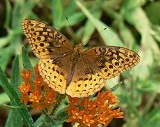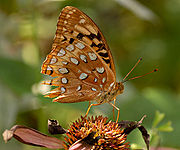
Great Spangled Fritillary
Encyclopedia

Description
The Great Spangled Fritillary (Speyeria cybele) is a butterflyButterfly
A butterfly is a mainly day-flying insect of the order Lepidoptera, which includes the butterflies and moths. Like other holometabolous insects, the butterfly's life cycle consists of four parts: egg, larva, pupa and adult. Most species are diurnal. Butterflies have large, often brightly coloured...
of the Nymphalidae
Nymphalidae
The Nymphalidae is a family of about 5,000 species of butterflies which are distributed throughout most of the world. These are usually medium sized to large butterflies. Most species have a reduced pair of forelegs and many hold their colourful wings flat when resting. They are also called...
family. It reaches 2 1/8 to 3" in wingspan. It is characterized by its orange color above with five black dashes near fore wing base and several iregualer black dashes at the base of the hind wing. In addition, two rows of black crescents run along the edges of the wings. Below, the fore wing is yellowish-orange with black marks similar to the upperside, with a few silver spots on the tip of the wing. The hind wing is reddish-brown with silver spots on the base and middle of the wing. A broad yellow band and silver triangles are the most notable qualities on the wing, next to the brown margin. Females tend to be darker than males and individuals from the western reaches of this species range tend to be brighter orange.Similar species include the Aphrodite Fritillary
Aphrodite Fritillary
The Aphrodite Fritillary is a fritillary from North America.This orange coloured fritillary has rows of dark dots or chevrons at the wing edges and black or brown lines more proximally. The ventral side of the wings are also orange with several rows of white dots. Its wingspan is between 51 and...
(Speyeria aphrodite), the Atlantis Fritillary (Speyeria atlantis
Speyeria atlantis
The Atlantis Fritillary is a butterfly of the Nymphalidae family of North America. It is from the Avalon Pennisula of Newfoundland and Labrador to northern British Columbia, across northern United States south as far as Colorado and West Virginia...
) and the Northwestern Fritillary (Speyeria hesperis
Speyeria hesperis
The Northwestern Fritillary is a butterfly of the Nymphalidae family. It is found in the Northwestern United States and Western Canada, as far east as Manitoba and the Dakotas....
).It is distinguished from the Aphrodite
Aphrodite Fritillary
The Aphrodite Fritillary is a fritillary from North America.This orange coloured fritillary has rows of dark dots or chevrons at the wing edges and black or brown lines more proximally. The ventral side of the wings are also orange with several rows of white dots. Its wingspan is between 51 and...
and Atlantis
Speyeria atlantis
The Atlantis Fritillary is a butterfly of the Nymphalidae family of North America. It is from the Avalon Pennisula of Newfoundland and Labrador to northern British Columbia, across northern United States south as far as Colorado and West Virginia...
Fritillaries by a wide light submarginal band on the hindwing and instead of black spots, black dashes form on the margins of the fore wing.
Range and Life Cycle
This species covers a wide range over North America Stretching from Southern British Columbia, eastward to Quebec and the Maritime Provinces down south west of the Rocky Mountains to California, and down east of the Appalachian Mountains from Maine to Northern Georgia. Curiously, it does not occur in the Midwest, or in the Great Plains. Prime habitat for this species includes moist meadows and deciduous woods in the east. In the west, it prefers moist pine and oak woods and is common around woodland edges.This species starts as an egg laid in the fall months, the caterpillar hatches from a brown egg and overwinters. It begins eating in March, generally only found on the wild violet, (Viola rotundiflora; and grows and changes in color from brown to black and produces prickly, black spines.
The Great spangled Fritilary flies quickly but pause to take nectar from a variety of blossoms including Black-Eyed Susan, Thistles, and others. Females mate in June or July and then proceed to hide, on bark, or under foliage till late August to September, to lay their eggs on the leaves of the viola. Males, which emerged earlier, in May to June, live only to mate and by this time are almost nonexistent. This species is more common in the East, int the West it is scarce, and this Western population is occasionally give species status, the Leto Fritillary, (S. leto). (Fullard & Napoleone, 2001).
Other
In 1985 Scottish music band Cocteau TwinsCocteau Twins
Cocteau Twins were a Scottish alternative rock band active from 1979 to 1997, known for innovative instrumentation and atmospheric, non-lyrical vocals...
released a song called "Great Spangled Fritillary"; it was the first of four tracks (each bearing Lepidoptera-influenced names) on their EP Echoes in a Shallow Bay
Echoes in a Shallow Bay
Echoes in a Shallow Bay is an EP by the Scottish rock group Cocteau Twins, released on 4AD. The EP features four non-album tracks. It was issued on 29 November 1985 two weeks after another EP entitled Tiny Dynamine. The two EP sets, which feature complementary artwork, were also released combined...
.
External links
- Great Spangled Fritillary, Wisconsin Butterflies
- Great Spangled Fritillary, Butterflies of Canada
- The National Audubon Society Field Guide to Butterflies, by Robert Micheal Pyle

